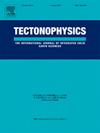Strong crustal heterogeneity of the Xianshuihe-Anninghe-Zemuhe fault system and its vicinity revealed by velocity and azimuthal anisotropy structures
IF 2.6
3区 地球科学
Q2 GEOCHEMISTRY & GEOPHYSICS
引用次数: 0
Abstract
The Xianshuihe-Anninghe-Zemuhe (XAZ) fault system acts as the eastern boundary of the Chuan-Dian block, and it separates the Chuan-Dian block from the Songpan-Ganzi block (SGB) and the Yangtze block. Due to the SE-ward expansion of the Tibetan Plateau, strong crustal deformation has occurred in the XAZ fault system and its vicinity. Although many studies on crustal deformation have been conducted in the past twenty years, some key issues remain poorly resolved. To further investigate crustal deformation, we perform P-wave anisotropy tomography using an eikonal equation-based tomography method, and obtain high resolution 3D P-wave velocity and azimuthal anisotropy images beneath the XAZ fault system and its vicinity. Our tomographic results show two separate strong low-velocity bodies in the mid-lower crust of the XAZ fault system. In addition, our results do not present a consistent anisotropy pattern with fast velocity directions parallel to the strike of the XAZ fault system. Based on these features, we conclude that mid-lower crustal flow, which is employed to explain the expansion of the Tibetan Plateau, does not occur along the XAZ fault system. Furthermore, our tomographic results display a high-velocity body in the upper crust below the SGB, and the high-velocity body connects with the high-velocity anomaly beneath the Sichuan basin (SCB). According to these features, we suggest that the Yangtze crystalline basement penetrates into the eastern Tibetan Plateau across the Longmenshan fault.
速度和方位各向异性结构揭示了鲜水河-安宁河-则木河断裂系统及其邻近地区强烈的地壳非均质性
鲜水河-安宁河-则木河(XAZ)断裂系是川店地块的东部边界,将川店地块与松潘-甘孜地块和扬子地块隔离开。由于青藏高原东西扩张,XAZ断裂体系及其附近发生了强烈的地壳变形。在过去的二十年里,虽然对地壳变形进行了许多研究,但一些关键问题仍然没有得到很好的解决。为了进一步研究地壳变形,我们采用基于斜向方程的断层成像方法进行了纵波各向异性层析成像,获得了XAZ断层系统及其附近地区的高分辨率三维纵波速度和方位各向异性图像。我们的层析成像结果显示,在XAZ断裂系统的中下地壳中存在两个独立的强低速体。此外,我们的结果并没有显示出与XAZ断层系统走向平行的快速度方向一致的各向异性模式。基于这些特征,我们认为用于解释青藏高原扩张的中-下地壳流动并不沿XAZ断裂系统发生。此外,层析成像结果显示,在SGB下方的上地壳中存在一个高速体,该高速体与四川盆地下方的高速异常相连接。根据这些特征,我们认为扬子结晶基底是通过龙门山断裂进入青藏高原东部的。
本文章由计算机程序翻译,如有差异,请以英文原文为准。
求助全文
约1分钟内获得全文
求助全文
来源期刊

Tectonophysics
地学-地球化学与地球物理
CiteScore
4.90
自引率
6.90%
发文量
300
审稿时长
6 months
期刊介绍:
The prime focus of Tectonophysics will be high-impact original research and reviews in the fields of kinematics, structure, composition, and dynamics of the solid arth at all scales. Tectonophysics particularly encourages submission of papers based on the integration of a multitude of geophysical, geological, geochemical, geodynamic, and geotectonic methods
 求助内容:
求助内容: 应助结果提醒方式:
应助结果提醒方式:


